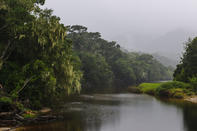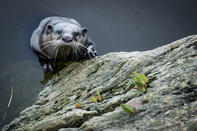Where Clear Waters Rise
The name Tsitsikamma can be loosely translated from Khoi to mean 'where clear waters rise'. At the time when white explorers first reached the dense, temperate forests of the Southern Cape, they found herds of elephant and buffalo, as well as other large game inhabiting the area.

It took less than a hundred years for them to be shot out (although a few lonely elephants survive in the Outeniqua Mountains), but some forest antelope, grey rhebok, bushpig, baboons and leopards do still occur within the trail environment.
Clawless Otters
The Otter Trail is probably the best known hiking trail in the country. This is hardly surprising, since in 1968 it was the first official trail to be opened, and it traverses some of the most dramatic, unspoilt natural terrain in Southern Africa. During the first decade it was used only sparingly, to the delight of trailists.
The animal for which this trail is named is the Cape clawless otter, although the spotted-necked otter also occurs here. The main difference between the species is that while the clawless otter frequents estuaries and coastal waters, the spotted-necked otter is found only in open, freshwater habitats.

The Tsitsikamma coastline is thus the perfect habitat for the clawless otter, with the result that there is one otter per kilometre of coastline here, the highest concentration in southern Africa. These animals are as much at home on land as they are in the water, and I once saw one scampering across the open grasslands of Moremi Game Reserve at midday, although they are most active in the early morning and evening. Along the Tsitsikamma coastline, however, they are mainly crepuscular.
Clawless otters can reach a length of 1,5 m and weigh as much as 18 kg. Depending on their habitat, their diet consists mainly of crabs, frogs and fish (making up about 90 per cent of the diet). Few wild animals are as endearing as these creatures: they love to chase each other around in the water, mock fighting and splashing, and will often play with small stones and sticks for long periods and with great dexterity.